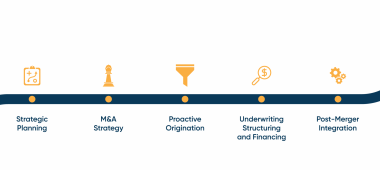COVID-19: We are in uncharted waters, facing unprecedented challenges, with little certainty regarding the length and severity of disruptions. You can pick your own clichés, but the message to CEOs is clear: This is your moment to lead your company through the immediate crisis and the likely subsequent recession. One thing is for sure, we are operating in a new paradigm that we need to quickly adapt to. The time for action is now– A wait-and-see approach is often the most damaging move in uncertain times.
While most available business articles are geared towards large multinationals that often have the luxury of operating remotely, we’ve noticed that traditional, mid-sized companies face this complex environment at a significant disadvantage, with limited capital and guidance. From our years of experience counseling middle market owners, we’ve modified the recommendations of leading business thinkers to be more relevant to the on-the-ground realities. Here are our top 10 immediate actions to survive and thrive during this ordeal:
- Personally monitor the business’ cash flow on a daily basis and prepare 13 week cash forecasts. Prioritize liquidity as much as possible by accelerating collections, delaying payables, and defensively drawing from your line of credit (credit availability can disappear overnight), if available. Defer all capital expenditures and longer-term strategic projects until the environment has stabilized.
- Unless absolutely necessary, strategically continue to invest in marketing, but reorient your messaging, taking into account recession psychology.
- Model your financial performance (and cash flow) based upon a variety of potential downside scenarios and develop a corresponding action plan with an increasing cascade of cuts, probably more aggressive than your team can imagine right now.
- Consider implementing a zero-based budgeting exercise to preserve “muscle” while reducing “fat,” expenses that can be cut without any noticeable impact to your business’s output or culture.
- Be aware of vendor exposure, and proactively stock up on mission critical supplies, as well as identifying alternative suppliers.
- Proactively inspire and lead, making sure that urgent “firefighting” does not inhibit your ability to stay abreast of changing conditions and to make the difficult strategic decisions. Remember, in times of heightened anxiety and stress, you should adapt your approach to be the leader your people need right now. Your vision must be clear to all employees, so everyone is working towards the same goal.
- Institute informal, daily CEO updates with the senior managers. Given the rapidly changing environment, err on the side of agile, localized decision-making. The volume of decisions and tasks is massive, so delegation is essential. Provide workers with the motivation and the responsibility to quickly escalate problems and to innovate to solve issues on their own, when possible.
- Communicate early, often, and transparently with your employees, customers, and suppliers; This is a defining opportunity to deepen your trust and relationships with your key stakeholders. Keep your messages concise and clear.
- Let all employees know how important they are and that the company is very concerned with their health and safety. Implement modified procedures, workflows, and policies to reduce the likelihood of infection and transmission within the organization, which could result in a major business disruption.
- If any functions are working from home, be patient, especially if remote work is new for your business. It’s easy for a remote worker to feel forgotten. Prioritize phone calls vs emails, utilize video-conferencing tools for meetings, and allocate time to check in on how employees are doing personally.
In the coming weeks, we’ll continue to share advice and best practices to navigate this crisis, and we hope you’ll share any valuable insights you’ve discovered as well. We’re all in this together.











